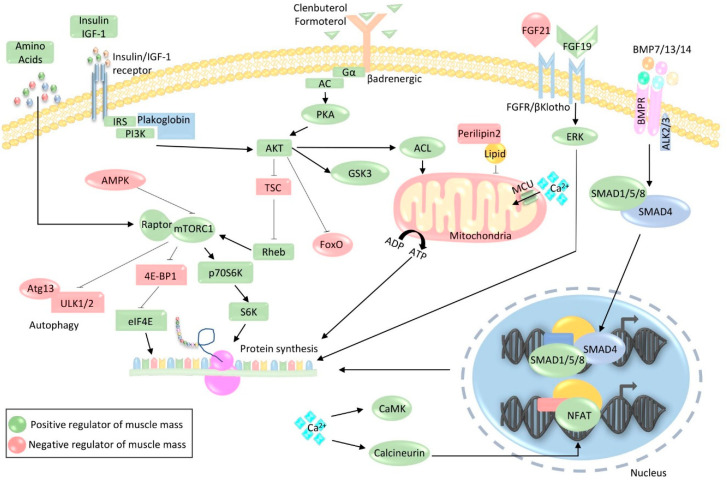Figure 1.
Pathways involved in protein synthesis. During muscle hypertrophy, the binding of insulin-like growth factor 1 (IGF-1)/insulin to their respective receptors activates IRS–PI3K–Akt–mTORC1 signaling, which is further stimulated by the presence of amino acids. The mTORC1 complex then enhances protein synthesis by inhibiting the eukaryotic translation initiator factor 4E (eIF4E) inhibitor 4E-binding protein 1 (4E-BP1) and activating p70S6K-S6-mediated protein translation. mTOR also blocks proteolysis by inhibiting autophagy initiation factors Unc-51 like autophagy activating kinase (ULK) 1/2. Clenbuterol and formoterol promote hypertrophy by binding to the adrenergic receptor and activating adenylate cyclase (AC)-PKA signaling, which culminates in the activation of Akt-mTOR. In addition to enhancing protein synthesis, Akt also blocks proteolysis by phosphorylating and inhibiting members of the forkhead box O family of transcription factors (FoxO), as well as activating glycogen synthase kinase (GSK) 3 and ATP citrate lyase (ACL). Fibroblast growth factor (FGF)19 enhances protein synthesis by binding to the βKlotho receptor and stimulating the extracellular signal-regulated kinase (ERK), which directly contributes to protein synthesis. Moreover, the binding of bone morphogenetic protein (BMP)7/13/14 to the BMPR receptor promotes muscle growth through the formation of a SMAD1/5/8–SMAD4 complex, which activates a hypertrophic transcriptional program. Calcium signaling also contributes to hypertrophy through the activation of calmodulin (CaM)-dependent kinase (CaMK) and phosphatase calcineurin, which stimulates the pro-growth transcription factor nuclear factor of activated T-cell (NFAT). Increased availability of nutrients and energy in the form of ATP further contribute to the auspicious environment that is permissive for muscle growth. Green shapes indicate positive regulators of muscle mass, whereas red shapes indicate negative regulators.

